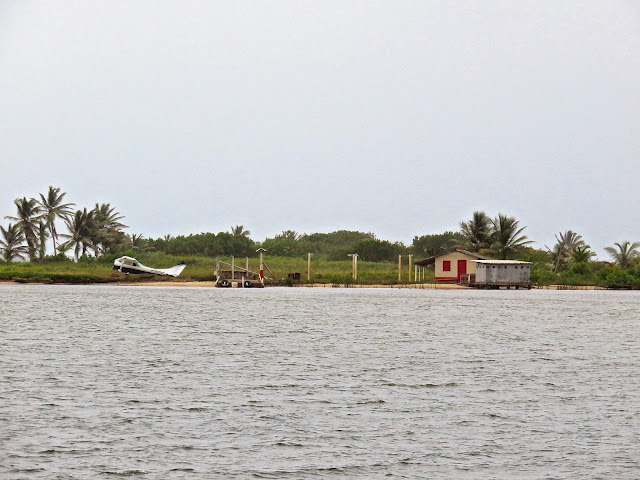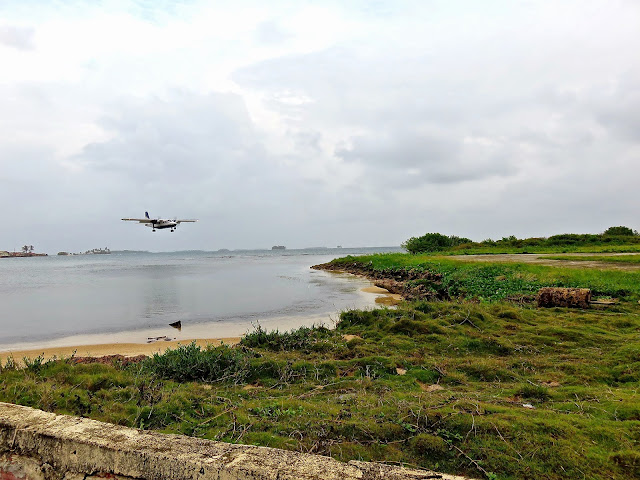We spent 3 days and nights sailing around the islands, and our activities included snorkeling the beautiful coral reefs, spearfishing, fishing, sampling the local freshly-caught seafood, and of course, learning more about the Guna people and their way of life. Our Captain, JC, an experienced sailor and world traveler who speaks 5 languages, and his wonderful crewman and jack of all trades, Roney, a Guna native, were great hosts. Together these two made a fabulous team, and it was a pleasure to spend our time in the Guna Yala archipelago with them. Their knowledge, enthusiasm, and passion for the area and the Guna people made our experience extra special and rewarding.
The Guna are small and short in stature (I fit right in!) and are quiet, but friendly people who live a simple life. Their native language is called Dulegaya, and many also speak Spanish. The Dulegaya language is predominantly oral, and written words have only started to be used within the past few years. Community life is egalitarian, and each person has his/her role within the community and all are expected to participate. Each island or community has it's own leaders, and the use of community meetings is the primary way that business and issues are discussed. The exportation of lobster and coconuts, as well as tourism, are the main sources of income for the Guna people. Men participate in community politics and fishing, and women have more traditional roles of working in the home. Women also make their brightly colored molas for which the Guna are so well-known.
 |
| We boarded the catamaran in front of Kuanidup Island. |
 |
| This is the first time Monica and Matt had ever been on a sailboat. They were very excited and loved it! |
 |
| Stunning and beautiful crystal-clear waters at our first destination. |
 |
| The primary transportation for Guna people is by dugout canoe, and it is not unusual for Guna to paddle for many hours to get from one island to another. |
 |
| To start of our adventure on our first day we stopped at this beautiful island to walk around and do a bit of snorkeling. |
 |
| Spectacular view from the other end of the island |
 |
| Monica and Greg enjoy a relaxing afternoon sail as we head towards the island where we will anchor and spend our first night. |
 |
| Monica |
 |
| Interesting cicada seen on board |
 |
| Turquoise Blue Waters |
 |
| We spent our first night anchored off this island. |
 |
| Guna were selling lobster on the island, and Roney bought a few (and some freshly made coconut rice) for our lunch - delicioso! |
 |
| Lunch! |
 |
| The exportation of lobster is one of the main sources of income for the Guna people. |
 |
| Most island shores are scattered with beautiful sea stars in all shapes, colors and sizes. The water is so clear, the sea stars can be seen from the sand. |



 |
| Molas generally come in pairs since they are worn on the front and back-side of a Guna woman's blouse. We purchased these two molas, in the image of a shark, from this Guna women. |
 |
| Guna men are often seen selling seafood in their dugout canoes. This man is cutting up conch. |
 |
| A Guna couple take a stroll on a small island that is only inhabited by 5 people. Island paradise! |

 |
| Monica loved snorkeling! |
 |
| Matt tries his hand at spear fishing. |
 |
| Beautiful coral and colorful fish |
 |
| Interesting Reef |
 |
 |
| Brain Coral |


 |
| Monica sits on the back of the boat, enjoying a leisurely day at Isla Verde. |
 |
| While we didn't have lots of sun on our trip, we enjoyed glassy seas and even had a few spectacular thunderstorms in the evening. |
 |
| Sailing the Guna Yala archipelago and seeing various uninhabited palm-studded islands was pretty spectacular. Many Guna transform their dugout canoe into a fully functioning sailboat with a homemade sail, as seen in this picture above. |
 |
| The exportation of coconuts is one of the Guna's primary sources of income. Coconuts are picked and gathered from the islands and exported to Colombia where they are processed. |
 |
| We had the pleasure of meeting this father and 3 sons who worked hard at collecting coconuts. They are sold for $0.40 each and exported to Colombia. |
 |
| Matt catches a fish! |
 |
| Monica loves snorkeling with her GoPro. |
 |
| We spent our final night anchored near Isla Corazon de Jesus so that we could be close to the airport for our early morning flight the next day. Corazon de Jesus is one of the more developed and somewhat less traditional islands. While many families still live in homes built of cane and thatch, other structures are built with concrete, as shown in this picture above. Small thatched huts built over the water are used as bathrooms. |
 |
| Roney takes Monica and Christina to Isla Corazon de Jesus.
Roney is a native of Isla Corazon de Jesus, one of the most developed islands. At the end of the trip, he took Monica and I on a special trip to his village, introduced us to his wife and daughter and then took us to a neighboring village to meet his mother as well. These personal village tours ended up being so interesting, and it was a true pleasure and honor to see how many of the Guna in this more developed area live.
|
 |
| This is the Corazon de Jesus airport! It is basically a fairly short airstrip, a small building for check-in, and another concrete building over the water that serves as a bathroom - very basic. |
 |
| Matt, Monica, and our fabulous Captain, JC, wait for our plane to arrive at the Corazon de Jesus airport. |
 |
| The Stoney Family with Captain JC and Assistant Roney at the Corazon de Jesus Airport. We've enjoyed a fabulous trip to the Guna Yala Archipelago and it's been a pleasure to learn more about this beautiful part of the world and the Guna culture. |
 |
| Our plane arrives! |
 |
| We hop into our small 7-seater airplane, and as we are flying over the islands we can't help but notice the small sign at the front of the plane over the co-pilot's dashboard. I'm thinking to myself, "How old is this plane?" It's all part of the adventure... |
 |
| The plane ride over the islands was beautiful, as we peered down below at the beautiful waters, abundant coral reefs, and palm-covered islands with white-sand beaches. Seeing the Guna Yala Archipelago from the air gives it a whole different perspective and was another adventure in and of itself - thrilling! |
 |
| One of the many islands in the Guna Yala Archipelago |
 |
| Island Paradise |
 |
| Flying over Panama City |












No comments:
Post a Comment